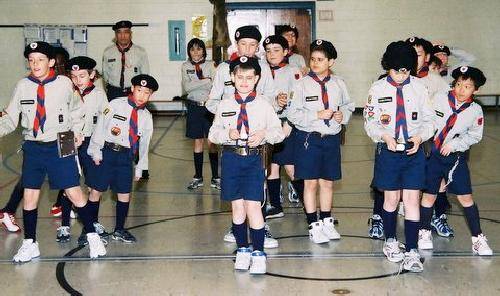
Figure 1.--Here we see a group of FSE Canada Timber Wolves playing a game during the weekly meeting. They are all smartly dressed in the uniform. |

|
The uniform has and will continue to play an important part of the FSE Explorer identity today and in the future. This movement works diligently to ensure a common look, especially at the Explorer and Wayfarer level within all 15 countries. Here we have some details on the various uniform garments. The FSE tells us, "The why and how of the uniform can be best summarized as follows: All FSE Explorers (in all 15 countries) wear the same uniform, which represents a highly visible image or a sign of a common and shared large family, a shared ideal and a sense of brotherhood or sisterhood. The uniform can vary somewhat at the Timber Wolf level. Care of uniform – members when putting on their uniform are expected to be careful in doing so, to have a clean uniform and to wear it neatly and completely.
We have some basic information about the FSE uniforms.
Otters do not wear any sort of headwear. Timber Wolves wear a unique and sharp looking black Basque beret, Explorers, Wayfarers and adult leaders wear a black parachutist beret. The beret will support the promise badge (for Timber Wolves) and the Promise Cross for Explorers, Wayfarers and leaders that one receives on the day that they make their promise to God, their fellow members and the movement. Note that the Timber Wolf red wolf badge is very similar to the red wolf badge that early British Cubs wore and the Timber Wolf badge is presumably modeled on it.
Uniform shirts – tan for all male members and a light blue for all female members. When one folds up their sleeves, it means that one is ready to serve. When one loosens the collar of her blouse or his shirt, one is prepared to welcome the demands of life with an open mind, with a “can do” attitude.
The belt has a Maltese Cross and the fleur-de-lis in the center along with a single decade rosary that is clipped onto the belt. The belt shows that one is always prepared. When one does up their belt it symbolizes that one “is ready to move out, to take action, to respond to directions from your leaders or fellow Explorers. Many Timber Wolves and Explorers wear a leather pouch on their belt to hold useful items.
boys wear uniform navy blue shorts with navy blue knee socks (longs can be worn by leaders when not with their youth and for interested male Wayfarers).
Girls wear uniform navy blue skorts with navy blue knee socks. Garter tabs are not used by either gender. The navy blue uniform shorts (males) or skorts (females) with knee socks represents one that is youthful, active, wearing a unique uniform generating an image that sets this movement apart from all others.
When one places their rucksack on their back, one accepts individual responsibilities, one demonstrates a sense of independence towards the management of money and other peoples goods while also showing a sense of readiness to serve.
The FSE Exploers wear a range of patches on their uniforms. The badges are places all over the uniform shirt and serve a variety of purposes. . Because of the similarities in uniforms, the various levels are inducated by a dagge on the left sleeve. Badges on the right sleeve indicate where the troop is located. A nadge over the right pocket indicates the Baden Powell program. And a left pocket badge shows the individual's rank. These are the major badges, but there are several others as well.
The FSE tells us, "The why and how of the uniform can be best summarized as follows: All FSE Explorers (in all 15 countries) wear the same uniform, which represents a highly visible image or a sign of a common and shared large family, a shared ideal and a sense of brotherhood or sisterhood. The uniform can vary somewhat at the Timber Wolf level. Care of uniform – members when putting on their uniform are expected to be careful in doing so, to have a clean uniform and to wear it neatly and completely. By wearing the complete uniform, the members show that they are not unduly influenced by the current “what’s in” fashion trend thereby not wearing superfluous clothing when active in the movement. When one is wearing their uniform, one accepts their place in the FSE Explorer family, one is reminded about the value of their Promise and the Explorer Law that they are expected to embrace and live day in and day out. The uniform is simple and straight forward, members are expected to accept it as it is, to not add or remove anything from the uniform that takes away from the sense of family, brotherhood or sisterhood.
The uniform when worn correctly and neatly clearly shows all fellow Explorers that one is “united” to the other 55,000 members in the International movement who wear a similar uniform and use the same badges." [Ritchi]
Ritchi, Paul. Group Leader, FSE Canada, E-mail, January 1, 2006.
Navigate the Historic Boys' Uniform Chronology Pages:
[Return to the Main chronologies page]
[The 1900s]
[The 1910s]
[The 1920s]
[The 1930s]
[The 1940s]
[The 1950s]
[The 1960s]
[The 1970s]
[The 1980s]
[The 1990s]
[The 2000s]
Navigate the Historic Boys' Uniform Web Site:
[Return to the Main FSE Canada page]
[Return to the Main Canadian Scout page]
[Activities]
[Biographies]
[Chronologies]
[Countries]
[Essays]
[Garments]
[Organizations]
[Religion]
[Other]
[Introduction]
[Bibliographies]
[Contributions]
[FAQs]
[Questions]
[Unknown images]
[Boys' Uniform Home]
Navigate the Historic Boys' Uniform Web organizatiion pages:
[Return to the National Scout page]
[Boys' Brigade]
[Camp Fire]
[Hitler Youth]
[National]
[Pioneers]
[Royal Rangers]
[Scout]
